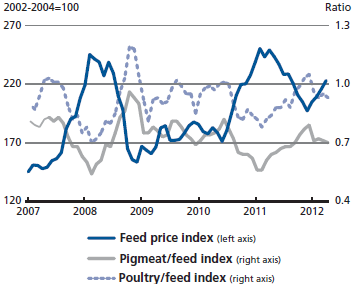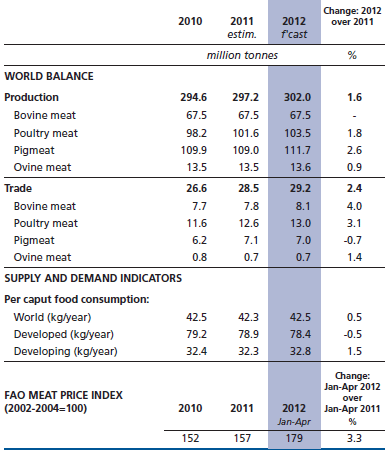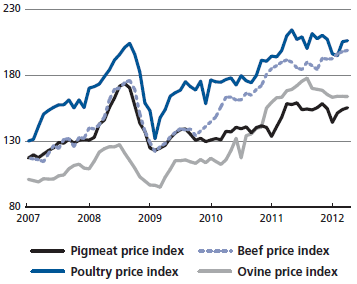



Food Outlook: Record Meat Prices Constrain Consumption Growth
Global meat markets in 2012 are expected to see a recovery of supplies in traditionally importing countries and strong competition for markets, according to the latest Food Outlook report from FAO. Near record prices are constraining consumption growth.Meat prices hover at near record levels
Global meat markets are likely to face heightened trade
competition in 2012, at the same time that recovering
meat production in Asia is set to dampen growth in global
import demand. Overall, meat trade is expected to expand
by 2 per cent, to 29.2 million tonnes, much of which is
anticipated to be taken up by developing country exporters,
which could increase their share of the global trade to 44
per cent.
Disease outbreaks in 2011, drought-reduced cattle
inventories and high feed costs sustained international meat prices to near record levels in the first quarter of 2012. In
April, the FAO meat price index edged up to 182 points,
surpassing the record 181 points registered in November
2011.


Indications of slowing import demand, especially for pig and poultry meats, portents a potential moderation of meat prices in the coming months, which, along with high feed costs, is raising concern about the profitability of the meat sector in 2012.
Bovine Meat
Drought and low animal numbers constrain bovine meat output
Global beef production is forecast to stagnate at around
67.5 million tonnes in 2012, as progress in developing
countries is offset by contraction of output in developed
countries. Much of the world increase is expected in Asia
and Latin America and the Caribbean, with some gains also
foreseen in Oceania. Beef production is forecast to decline in
North America and in Europe.
In Asia, India is foreseen to lead a beef expansionary
drive thanks to three new export-oriented slaughter and
processing facilities opened in 2011. In the Republic of
Korea, government incentives to slaughter low-performing
cows are behind an anticipated 27 per cent jump in beef output this year. On the other hand, a self-sufficiency policy
stance in Indonesia has led to the halving of the live cattle
import quota, a move that may stifle production growth
this year. After two years of decline, output in Latin America
and the Caribbean is set to rebound in 2012 on the heels
of recovering output in Brazil. In Argentina, despite the
closure of almost one-fourth of its meat plants over the past
three years and a drop in cattle numbers to their lowest
since 2007, a drought-induced rise in slaughter numbers
may prompt a 3 per cent production increase. In Uruguay,
tight cow supply and a lack of suitable steers have reduced
slaughtering to a 4-year low, while Paraguay is struggling
in the wake of last year’s foot-and-mouth disease (FMD)
outbreak. In Africa, prolonged drought has meant reduced
foliage and pastures in the eastern and, increasingly, western
parts of the region, leading to high livestock mortality and
disease outbreaks. In Egypt, the spread of a new strain
of FMD is resulting in animal culling and restricted animal
movements, which may depress output in the country by
12 per cent and suppress production growth in the Africa
region in 2012. Among developed countries, a mild winter
in Canada and favourable pasture conditions in Australia
and New Zealand are expected to raise carcass weights
and boost beef production. By contrast, a decade of policyinduced
cuts in cattle numbers in the EU, the Russian
Federation and the Ukraine are forecast to depress output
in 2012. This, combined with the worst drought on record in
the United States, which has cut cattle herds to the lowest
since the 1950s, is set to reduce developed country output
by 2 per cent to 29.4 million tonnes.
Short supplies in major markets buoy beef trade prospects
Contrasting with lackluster production prospects, the outlook for beef trade is favourable, with an anticipated 4 per cent increase in 2012, to 8.1 million tonnes. Much of the growth relies on expectations of larger imports by the United States and the EU, two key traditional beef exporters, in response to short domestic supplies. Exports from the United States, expected down, may be additionally pressured by the recent discovery of a BSE cow in California. Falling production in the Russian Federation, the second largest beef importer, will combine with a WTO-induced increase in the country’s tariff-rate beef import quota, to reverse four years of declining purchases. Growing demand in the Far East and Middle Eastern markets, in particular Viet Nam, Malaysia, Saudi Arabia, Egypt and the Philippines, are forecast to boost their imports, especially of low-priced buffalo meat originating from India, while Venezuela’s imports will be buoyed by recently signed trade agreements. Japan’s purchases, which rose in 2011 despite a slow economy and food safety concerns related to the nuclear disaster, are expected to stay stable, while demand from China will be dampened by the relative high international beef prices as compared with pigmeat.

Despite expectation of slight increases in exports from Australia, New Zealand and Canada, most of 2012’s trade increase is expected to be captured by developing countries, particularly Brazil and India. In fact, developing countries are expected to supply more than half of the global market in 2012, signaling a historic reversal in the pattern of bovine meat trade. Brazil’s position as the world’s largest beef exporter will be buoyed by a gradual re-authorization of plants to export to the Russian Federation. Argentina may also ship more, subject to the government’s issuance of export licenses. Competitive prices and growing export availabilities, on the back of an expanding dairy sector, could also increase exports from India by 20 per cent to 1.3 million tonnes, which would make it rival the United States as the third largest beef exporter after Brazil and Australia. For the third consecutive year, beef exports may decline in Uruguay, constrained by drought-reduced cattle inventories, while high international prices will facilitate deliveries by smaller non-traditional beef exporters, such as Mexico, Nicaragua and Costa Rica.
Further Reading
| - | You can view the full report by clicking here. |
|
| - | Go to our news item on this story by clicking here. |
May 2012


